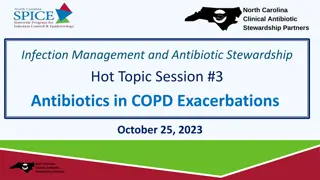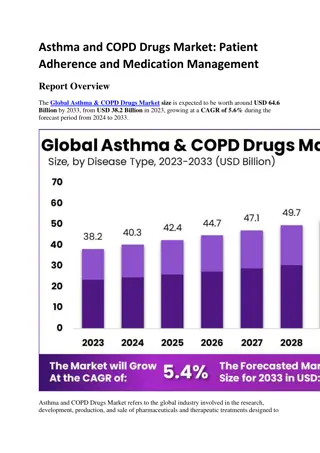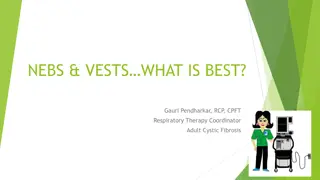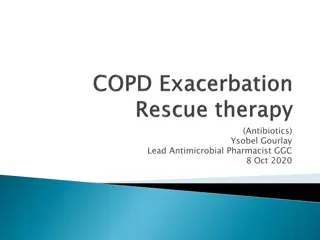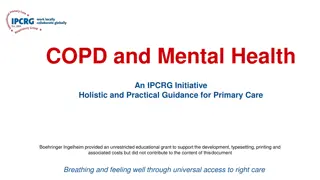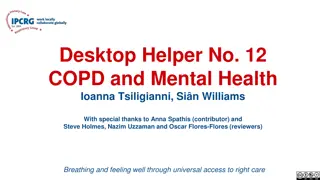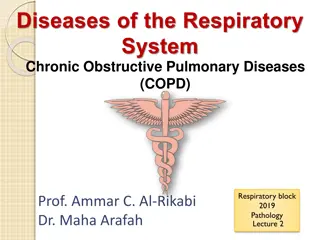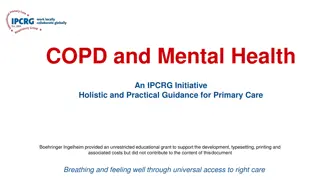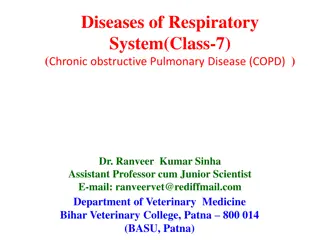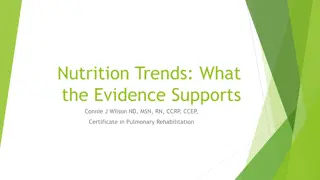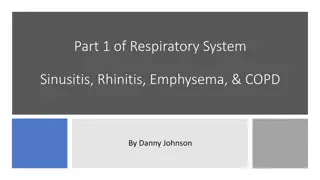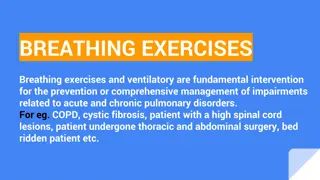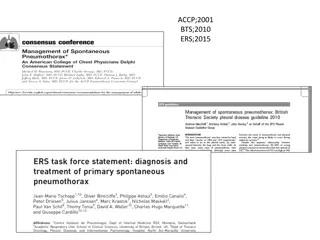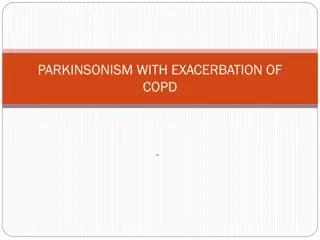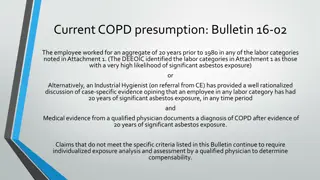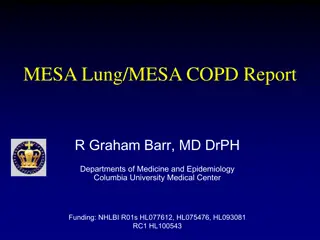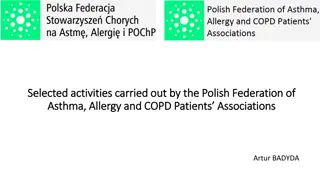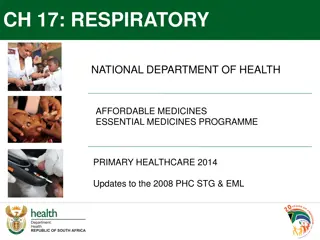Understanding and Managing COPD Exacerbations
COPD exacerbations are acute episodes of clinical instability characterized by worsening respiratory symptoms beyond daily variations. They are significant due to their impact on health-related quality of life, accelerated loss of lung function, increased hospitalizations, mortality, and healthcare costs. Preventive measures and proper management strategies are crucial in reducing exacerbations and improving COPD outcomes.
Download Presentation

Please find below an Image/Link to download the presentation.
The content on the website is provided AS IS for your information and personal use only. It may not be sold, licensed, or shared on other websites without obtaining consent from the author. Download presentation by click this link. If you encounter any issues during the download, it is possible that the publisher has removed the file from their server.
E N D
Presentation Transcript
Prediction and management of COPD exacerbation Miguel Rom n-Rodr guez
What is an exacerbation? Acute episode of clinical instability occurring in the natural course of the disease and characterized by a sustained worsening of respiratory symptoms, which goes beyond the daily variations. The main symptoms referred are worsening dyspnoea, cough, increased volume and changes in sputum color. Worsening Acute Beyond daily variations
Are exacerbations important? Decrease health related quality of life Acelerated Loss of FEV1 Exacerbations Increased hospitalizations and mortality Increase in health expenditure 1. Spencer et al Eur Respir J. 2004;23:698-702. 2. Donaldson et al Thorax. 2002;57:847-852. 3. Gunen et al Eur Respir J. 2005;26:234-241. 4. Wouters et alRespir Med. 2003;97(Suppl C):S3-S14. .
Exacerbation natural history 100 suffering 1 exacerbations/year 90 Proportion of COPD patinets 80 69% 70 57% 60 50 44% 40 30 20 10 0 GOLD II GOLD III GOLD IV Hurst JR et al.N Engl J Med 2010;363:1128-38.
Exacerbation natural history 2.0 Hospitalizations Exacerbations 1.8 Exacerbaciones por paciente y a o 1.6 1.4 1.2 1.0 0.8 0.6 0.4 0.2 0.0 GOLD II GOLD III GOLD IV Hurst JR et al.N Engl J Med 2010;363:1128-38.
Exacerbation natural history Survival Probability 1,0 No exacerbations 1 2 exacerbations/year 3 exacerbations/year 0,8 p<0,0002 0,6 p<0,0001 p=0,069 0,4 0,2 0 Time (months) 0 10 20 30 40 50 60 *COPD exacerbations requiring hospitalization at baseline Soler-Catalu a JJ, et al. Thorax. 2005; 64: 925-31
Management COPD Exacerbation diagnosis STEP 1 Severity assesment STEP 2 Etiology STEP 3 Primary Care Hospital Treatment STEP 4 Primary Care Hospital
COPD Exacerbation diagnosis STEP 1 4 weeks from previous exacerbation worsening of respiratory symptoms COPD + + Clinical suspicion Current or Ex Smoker More than 35 years old Symptoms + + Spiromety + BDT FEV1/FVC postbd <0.7* (*use LLN if >70 or < 50)
COPD Exacerbation diagnosis STEP 1 4 weeks from previous exacerbation worsening of respiratory symptoms COPD + + Clinical suspicion With NO spirometry No COPD exacerbation diagnosis Only PROBABLE COPD exacerbation Once estable (4 weeks): PERFORM SPIROMETRY
COPD Exacerbation diagnosis STEP 1 4 weeks from previous exacerbation worsening of respiratory symptoms COPD + + Clinical suspicion Diferential Diagnosis Pneumonia Pulmonary Embolism Cardiac Failure COPD exacerbation Arrhythmia Thorax thrauma Neumoth rax Pleural effusion
STEP 2 Severity assesment Muy grave Very Severe Severe Grave Moderada Moderate Leve Mild At least one of the following Respiratory arrest Decreased level of consciousness Hemodynamic inestability Severe Respiratory acidosis (pH < 7,30)
STEP 2 Severity assesment Severe Severe Very Severe Grave Moderada Moderate Leve Mild At least one of the following and none for very severe PaO2> 45 mm Hg Recent Cyanosis Moderate respiratory acidosis (pH: 7,30-7,35) Use of accessory muscles Peripheral edema Severe significant comorbidity SatO2 < 90% o PaO2 < 60 mm Hg*
STEP 2 Severity assesment Very Severe Moderada Moderate Moderate Severe Grave Leve Mild At least one of the following and none for severe FEV1< 50% Cardiac comorbidity High risk for treatment failure Previous exacerbation during the past year
STEP 2 Severity assesment Very Severe Mild Mild Severe Grave Moderada Moderate Leve None of the previous criteria
Etiology STEP 3 Anamnesis y exploraci n f sica SpO2 Other dyspnoea causes COPD exacerbation Purulent sputum EKG X-Ray No YES Pneumonia Arrhythmia Cardiac Failure Ischaemic C. BACTERIAL Neumothorax 1 Anthonisen criteria (excluding purulence) 2 Anthonisen criteria Thrauma Others Possibly bacterial Not clear etiology Virus
STEP 4 Severity and etiology assesment Primary Care Mild Moderate Severe/Very severe Short acting BD Short acting BD Optimize comorbidity treatment Optimize comorbidity treatment Oral Corticosteroids Purulent sputum? Purulent sputum 2 Anthonisen criteria 1 Anthonisen criteria No Yes Antibiotics Antibiotics No antibiotics No antibiotics Optimize basal treatment Optimize basal treatment 72 hours follow-up visit 72 hours follow-up visit Hospital care Improvement Improvement No improvement No improvement
And always Maintain a correct ventilation: Oxigen-therapy if needed (O2sat <90) Low flow/concentrations to avoid hipercapnia (sleepiness, flapping) Use ventimask 24-28% or nose goggles 2-4 l/min Try SABA or SAAC with a chamber/spacer. Not together from start Nebulization does not improve effectiveness of medication Repeat every 20 minutes Systemic Corticosteroids in moderate-severe exacerbations Try to use oral CS not intramuscular (prednisone 30 mg) Antibiotics if purulent sptum Follow local recomendations according to ressistance Quinolones (cipro) if high risk for pseudomona Optimize co-morbidity treatment


